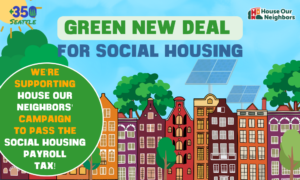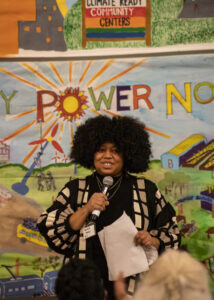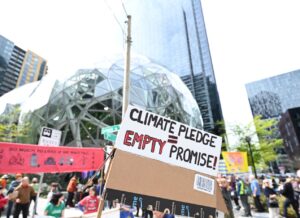by Andrew Kidde
“If the climate were a bank, it would be saved by now.”
For climate activists this dark humor holds a difficult truth. Climate change is a kind of threat people aren’t generally good at responding to. We respond promptly and consistently to imminent personal threat. (Bank failure anyone?) But people typically believe climate change catastrophes are off in the future and will affect faraway countries. When compared to the here and now problems of budget, family, and community, it’s easy to see climate change as low priority.
Engaging people with climate change has another challenge — people respond to crisis best when they know what to do. But responding to climate change requires systemic changes, so it’s hard to know where to start. It also requires a daunting degree of expertise, coordination, and leadership. When I tell people I’m a climate activist, they often thank me. It’s such relief to believe that others are dealing with it.
In the face of the tendency to discount the significance of climate change and to be overwhelmed by what to do, we climate activists must learn to communicate about our issues so listeners see climate change as a priority, and so they see a clear role for themselves. Here are some ideas as to how to do that as you testify at hearings, make presentations, or give your “elevator” speeches… (The model I present here is based in part on this piece from Yale Program on Climate Change Communication.)
Climate activists have a tendency to lead off with facts and data that tell the story of how horrible the situation is becoming. But it turns out people have a lot of practice at discounting facts. Newspapers have for centuries bombarded us with horrifying facts of remote suffering. We are so overwhelmed by these stories that we tune them out, or just think, “that’s sad” and move on. Also, when facts challenge the core beliefs of a community people will ignore the facts as a way of staying loyal to their community. For example, the right to drive a gas-powered automobile is a basic assumption here in the USA. Continuing to hold that assumption is much easier than accepting the fact that car exhaust contributes to climate change. There is even evidence that people will cling more strongly to their beliefs when factual arguments against them are raised… See here for more on this. The point is that data-rich climate communications can backfire because they trigger these discounting responses.
Personal stories, on the other hand, are harder to discount. By leading with a personal story about the neighborhood kids with asthma, a mother who was displaced by a forest fire, or parental worry about a son or daughter’s future, climate activists can engage listeners emotionally and connect with them directly. Even though these stories pale in comparison to the human suffering of, say, millions of Bangladeshi climate refugees, they are more effective because they break down the audiences’ discounting tendencies. Personal stories then give an opening to begin with the factual, data part of the message.
If your audience members are not experts, you probably only need a couple of simple and relatively well-known facts (simple graphics help too). People are more likely to recall information when they have heard it repeatedly, as linguist George Lakoff reminds us here. So, repeat the basics: “97% of climate scientists believe that humans are causing climate change”; “the last 10 years have been the hottest on record;” and “the American Public Health Association states that the science is clear: climate change is a serious threat to human health.”
Remember also that these central facts of climate change have been attacked by a well-funded disinformation campaign conducted by the oil industry. So forewarn your audience that they may encounter propaganda intended to sow doubt about climate change. Let them know that these messages are created by companies with a financial interest in fossil fuels. More on this here.
Relating personal stories and key facts helps elevate the importance of climate change in people’s minds. But we also need to help our audiences figure out that they can and should do something about this. Motivating your audience is key, and you can do this by referring to societal norms that support action: protecting and caring for youth; being stewards of the land; caring for our fellow human beings. Note that climate work is justice work and that those who are suffering the most, have done the least to cause the problem. Appeal to their humanity. Despite what some cynics might say these intrinsic reasons for taking action are powerful.
Extrinsic motivation helps too, especially when joined with intrinsic motivation. Here you can note that many of the needed changes to fight climate change have immediate and local benefits: cleaner air is good for our health; the transition to green energy will bring jobs; and renewable energy is typically produced locally which means keeping money in the community.
Finally invite your audience to take a specific action and join a specific organization. Write your legislators and tell them to support a carbon tax, join 350 Seattle to stay informed on other things to do.
To summarize here is one model of climate messaging:
- personal story
- key facts (with warning about propaganda from oil companies)
- societal norms that support taking action
- immediate and local benefits of taking action
- invitation to specific action
This is not the only approach. [Another technique is to use a classic narrative structure: Threat – Villain – Solution. See here for more info on that.] But the model does help address two central problems of getting people involved: their tendency to discount the threat of climate change, and their confusion on how to get involved.








